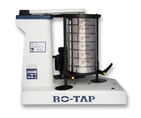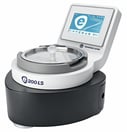3 Particle Size Analysis Instruments Used in the Food Industry
The food industry is arguably one of the most regulated industries in the world, as the mishandling of food products can have detrimental side effects. One key element of these standards and regulations is food quality control.
Food quality control technicians must implement a reliable means of particle size analysis to ensure a quality control level suitable for the mass production of food goods.
What equipment options are currently available to ensure precision and care in handling food safety and quality control?
With over 140 years of particle size analysis experience, W.S. Tyler is here to ensure you implement the best solution for your particular needs.
In this article, we will discuss everything you need to know about particle size analysis in the food industry, explaining how the food industry fits into the particle size analysis industry, what instruments are used to carry out and providing insight into some of the equipment used to analyze the particle size of your material.
How Does the Food Industry Fit Into the World of Particle Size Analysis?
When talking about food safety and quality control, particle size analysis comes into play in several ways. The two main ways the size of particles in a food product is analyzed are final product sizing and initial product sizing.
So what’s the difference?
Well, initial product sizing refers to the analysis of powdered or raw ingredients at the beginning stages of production. These ingredients go into things such as curry spice blends or cake mixes.
On the other hand, final product sizing refers to the analysis of the particle making up the final production run to ensure its within a certain size range. This includes products like table salt, granola, and sugar.
How Does Particle Size Analysis Benefit the Food Industry?
Particle Size Analysis allows food manufacturers to meet the expectations of their customers by enhancing their food quality control protocols. To put this into perspective, let’s say you are a manufacturer that sells tea bags.
If a customer purchases your tea bags, they expect each cup of tea to taste the same if they steep each one for three minutes. Particle Size Analysis helps to guarantee this, by allowing you to make sure the leaves within a batch have been cut to a similar size.
The same goes for food that needs to be cooked. Particle Size Analysis helps to ensure that a food product will cook at the expected rate.
What Equipment Is Used to Aid Food Safety and Quality Control?
In the food industry, three particle analysis instruments can enhance most food quality control protocols: Sieve Shakers, Air Jet Sieves, and Dynamic Image Analysis Systems. Let’s examine how each instrument is implemented.
1. Sieve Shakers

Sieve Shakers use an oscillating motion along with a hammer tapping motion, to promote particle movement through a test sieve stack. This simple yet effective system was discovered to produce some of the most repeatable results in the industry.
This is why Shakers, such as the RO-TAP® Sieve Shaker, have been a highly consistent particle size analysis instrument for several decades. In fact, one of the greatest benefits that it brings to the table is that it can easily be traced to several industry standards.
This means that all the necessary quality control paperwork is readily available during an audit.
That being said, this particular unit can be fairly loud. When not placed into a sound enclosure, it can sometimes prove to be a disruption.
Also, a RO-TAP Sieve Shaker has many moving parts that will wear over time. This means some maintenance is required from time to time, though most maintenance can be carried out easily.
NOTE: Because food production is such a highly regulated process, it is recommended that certified test sieves are used.
2. Air Jet Sieve

Air Jet Sieves, such as the NEXOPART® Air Jet Sieve e200 LS, are a unique solution that provides food quality control technicians with a complete particle size analysis experience. These units are particularly useful when working with material that often becomes agglomerated, such as flour and confectioner’s sugar.
The Alpine Air Jet Sieve e200 LS uses a vacuum-generated jet of air to slam agglomerated particles against its plexiglass lid, allowing them to separate and flow through the test sieve. This unique vacuum system makes air jet sieves the ideal solution for any operation working with lighter particles.
However, these light particles can cause a lot of build-up within the air jet sieve filters as well as the vacuum that generates the air jet. As a result, the food quality control technician must follow a regular cleaning schedule to ensure it continues to operate as it should.
NOTE: The Alpine Air Jet Sieve e200 LS must undergo calibration annually
3. Dynamic Image Analysis

Dynamic Image Analysis Systems take the benefits listed above a step further by providing insight into the size as well as the shape of the particle being worked with. This is extremely beneficial if, let’s say, you know you want 80% of your particles to be triangular in shape, you can set up parameters to see this.
Systems, such as the NEXOPART® Computerized Particle Analyzer, are also some of the fastest particle size analysis instruments on the market. Dynamic Image Analysis Systems can run a sieve analysis or sieve distribution in three minutes.
Compared to the 30-60 minute time frame associated with sieve shakers and air jet sieves, this can prove extremely beneficial to any situation.
It should be noted that dynamic image analysis systems have yet to be reflected in industry standards. In order to ensure you are producing results that adhere to industry standards, a stack of master sieves should be use to test your material monthly.
The correlation of these results will allow you to check the accuracy of your dynamic image analysis system.
What Concerns Come With the Omission of Particle Size Analysis?
When you neglect to implement a reliable particle size analysis in your food quality control process, you run the risk of having a product that simply doesn’t meet the quality that is expected. So, for example, if you ground coffee from a manufacturer that doesn’t use particle analysis at some point in their quality control process, the taste of the coffee will be inconsistent and customers may begin to deter customers from buying your products.
The same goes for products that give consumers directions on how to prepare them, such as cake mix. If the manufacturer is not checking the particle sizes within the mixture, the end-user, after following the directions carefully, will end up with a cake that sinks, burns, or causes illness.
To put it simply, particle size analysis is just a good way to meet industry standards while also leaving consumers happy and satisfied.
Food Safety and Quality Control Made Easy
Standing as one of the most heavily regulated industries in the world, the food industry relies on particle analysis to ensure product quality. As a result, food quality control technicians must implement reliable tools that are best suited for their process.
That said, there are three particle size analysis instruments used to enhance quality control:
- Sieve Shakers are best for those looking for an inexpensive solution that has been incorporated into dozens of industry standards.
- Air jet sieves are ideal for working with agglomerated materials that are difficult to test with other particle analysis methods.
- Dynamic image analysis is a great solution for those conducting multiple tests an hour with multiple technicians conducting these tests.
Having worked in particle size analysis for 140 years, W.S. Tyler has the know-how needed to ensure that you implement instruments that will help you produce safe and satisfying goods for consumption.
To learn how particle size analysis can enhance your quality control process, take a moment and review our Test Sieves, Sieve Shakers & Particle Analysis Equipment Product Guide.
Additional Articles You May Find Helpful:
- NEXOPART® Air Jet Sieve VS RO-TAP® Sieve Shaker
- Sieve Shaker VS Computerized Particle Analyzer (CPA)
- NEXOPART® Air Jet Sieve VS Computer Particle Analyzer (CPA)
Want all the latest industry trends and innovations sent directly to your inbox? Subscribe to our monthly newsletters today.
About Ronnie Brown
Ronnie is the Content Writer for W.S. Tyler and has four years of experience as a professional writer. He strives to expand his knowledge on all things particle analysis and woven wire mesh to leverage his exceptional writing and graphic design skills, creating a one-of-a-kind experience for customers.




